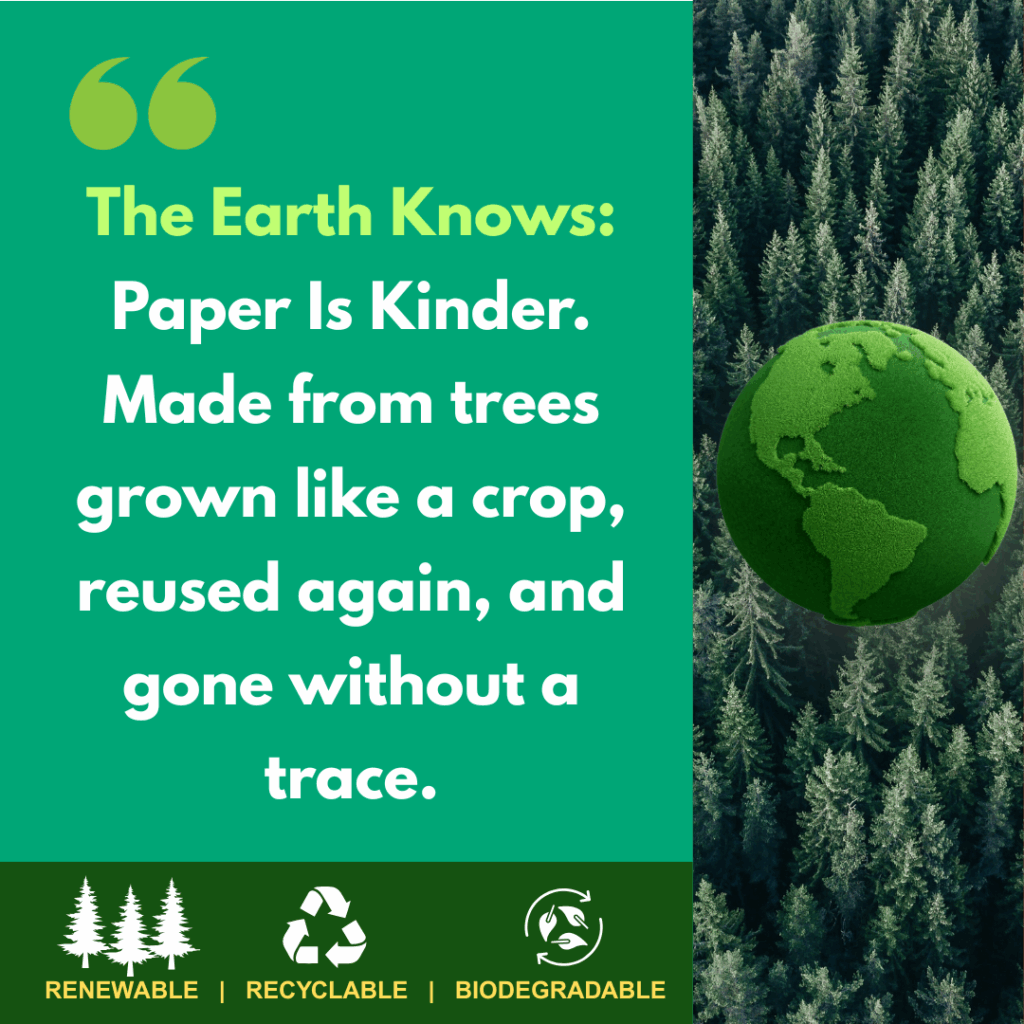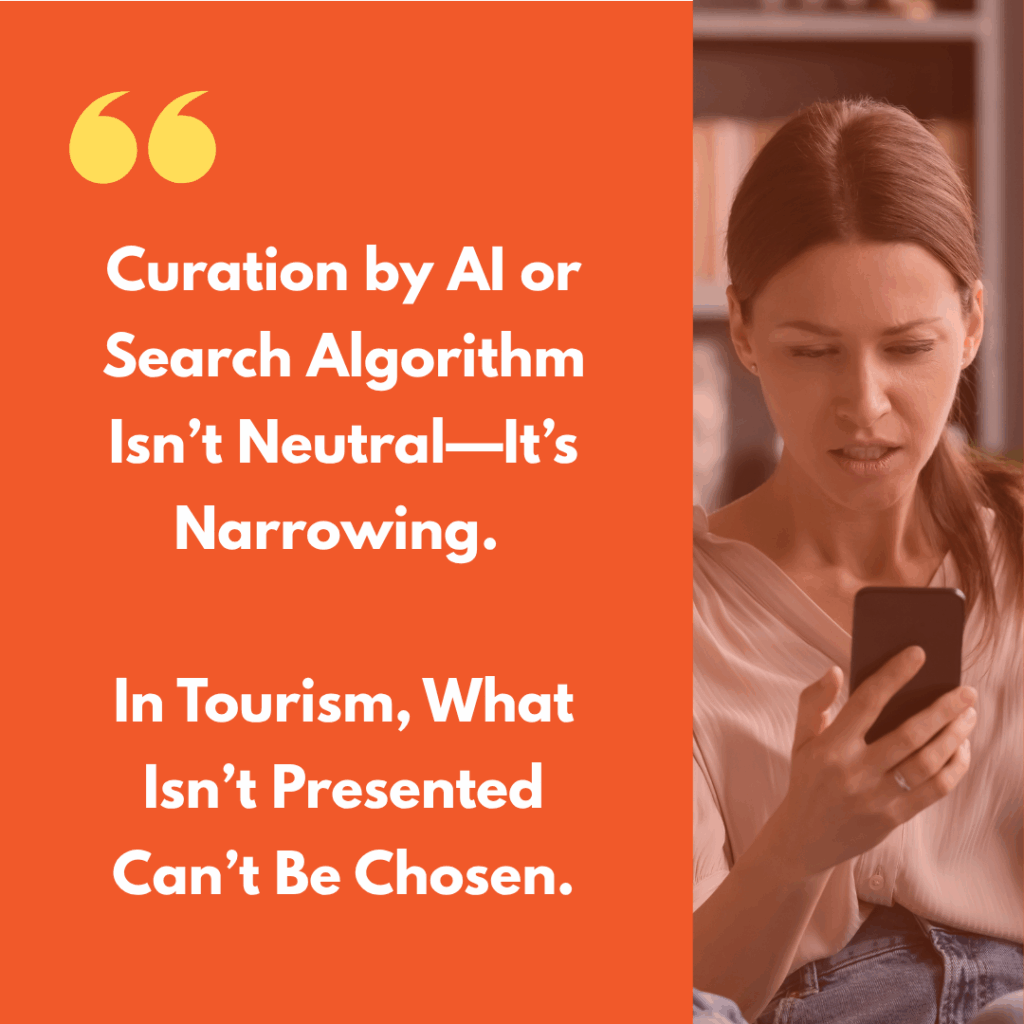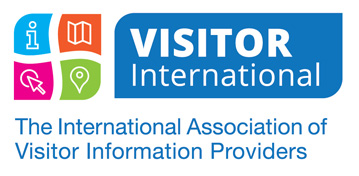The Future of Visitor Information: The Shifting Landscape of Influence and Sustainability
As AI reshapes discovery and environmental costs climb, the way we influence visitors must be rethought.

Right now—and accelerating fast—many travelers are planning entire trips through AI. No traditional browsing, just spoken or typed prompts answered by automated agents. Listings and ads in traditional search are becoming less visible, content is generated in milliseconds, and recommendations are served by machine-learned preferences. It sounds efficient.
But this raises serious concerns for tourism and other businesses. The more seamless and automated discovery becomes, the more we risk losing something human—and something essential. When algorithms decide what’s relevant, entire businesses can vanish from view. Small businesses, local experiences, and even well-established operators may simply not appear—not because they aren’t worth visiting, but because machines have filtered them out. Visibility is shrinking.
At the same time, the environmental cost of digital infrastructure is rising sharply—from the massive energy and water demands of AI systems to the growing burden of e-waste and resource extraction.
In a future defined by filtered content, shrinking attention, and rising digital impact, print will matter more—not less. Visitor brochures will become increasingly vital: tangible, trusted, and intentionally chosen. They offer what algorithms can’t—a guaranteed visible presence, a moment of pause, and a deeper and greener way to connect travelers with real experiences.
A Saturated Information System: Digital’s Fracture Points And Vanishing Search
We are, by any measure, oversaturated with content and noise. Globally, nearly one in three internet users now blocks digital ads—over 900 million people aged 16 to 64 who are actively opting out of online marketing altogether.
And even among those who don’t block ads, engagement is vanishingly low. Eye-tracking studies show that 44% of digital ads are never viewed, and only 4% hold a viewer’s attention for more than two seconds. The rest are scrolled past instinctively—dismissed before they’ve even been read.
Social media feeds are flooded with pushed content no one asked for, much of it now generated by AI instead of people. Email open rates continue to decline. And search—once a gateway to discovery—is changing fast.
Large numbers of users are no longer scrolling down the results page. Instead, they’re stopping at the AI-generated summaries that sit above search, where content is pre-digested and reduced to a handful of safe, simplified answers. For many tourism-connected and other businesses, this shift is critical: fewer people are seeing actual listings, fewer are exploring, and fewer are discovering anything new.
Search, in many cases, isn’t helping visitors find options. And for businesses, the opportunity to be found is vanishing with it.
But beyond the issue of attention lies something even more urgent: the environmental cost of digital infrastructure is rising fast—and is forecast to escalate dramatically.

- Data centers already consume 2–3% of global electricity, with projections suggesting this could rise to 8% by 2030, largely driven by the rapid expansion of AI (IEA, 2024). That’s equivalent to the total energy use of some of the world’s largest economies—placing immense pressure on power grids and raising serious environmental concerns.
- But energy is only part of the story. Data centers are also vast consumers of water, used primarily for cooling. According to recent studies, the average data center can use between 1 million and 5 million gallons of water per day—roughly equivalent to the daily water needs of a town of 10,000 to 50,000 people (Uptime Institute, 2023). And with AI workloads demanding more processing power and heat dissipation, water requirements are set to rise significantly.
- What this means is clear: the environmental cost of storing, processing, and delivering digital content is no longer invisible. As AI accelerates demand, both electricity and water use will surge.
- A single generative AI query can use up to 10 times more energy than a standard Google search (MIT Technology Review, 2023).
- The world produces over 60 million tonnes of e-waste annually, with low recycling rates—a figure expected to increase with every device refresh cycle. Most of this waste ends up in landfills or is improperly processed, polluting soil, air, and water. The toxic materials it contains linger for centuries, damaging ecosystems and poisoning the environment for future generations.
- Mining for cobalt, lithium, and rare earth minerals—essential to the devices and data storage systems that power digital life—is causing ecological degradation and displacement.
This is not a marginal issue. It is becoming one of the defining environmental challenges of our time—and one that can no longer be separated from how we communicate with, and market to, travelers.
Print Reconsidered: Naturally Renewable, Quietly Powerful
In the face of escalating digital waste and energy use, there is a growing realization—among governments, sustainability advocates, and marketers—that print is not an environmental villain. It's the opposite.
Visitor brochures, maps, and printed guides offer a radically different environmental profile from their digital counterparts. They are not fossil-fueled, energy-hungry, or dependent on rare earth minerals. They are natural, circular, and low impact—and they quietly outperform digital on every sustainability metric that matters.

- Paper is renewable—and forests are growing. Most brochures are made from wood harvested from sustainably managed forests—grown like a crop, with more trees planted than cut. In fact, European forests have been expanding steadily, with net growth equivalent to 1,500 football fields per day (FAO, 2023). North America and other parts of the world also operate under strict forest certification schemes. This means print doesn’t deplete natural resources—it supports managed growth.
- Paper stores carbon. As trees grow, they absorb carbon dioxide from the atmosphere. That carbon remains locked in the fibers of paper throughout its life. And because forests are expanding, more carbon is being absorbed and stored, making sustainably sourced paper a positive for climate.
- Brochures are one of the world’s most recycled products. Paper recycling rates in developed regions average over 70%, and many brochures are printed on recycled stock—creating a powerful closed loop.
- Brochure are biodegradable. When a brochure is no longer needed, it breaks down naturally—typically within weeks—and returns to the earth without causing harm. By contrast, digital devices and batteries can persist for centuries, leaching heavy metals, synthetic compounds, and toxins into soils, air, and waterways.
- Once printed, brochures require no electricity, no screen, and no ongoing infrastructure. Their environmental footprint ends at the point of production—unlike digital content, which continues to consume energy and resources every time it’s accessed.
As the environmental cost of digital becomes harder to ignore, the advantages of print are becoming impossible to overlook. The business sector is starting to wake up to this truth: when done right, print isn’t just effective—it’s fundamentally aligned with a sustainable future.
The Power of Touch: Chosen, Held, and Remembered

As digital engagement becomes faster, thinner, and more forgettable, print offers something the modern visitor doesn’t realize they’ve been missing—a moment of pause.
Brochures are not pushed, fed, or forced. They are chosen. Picked up by hand, flipped through at leisure, placed on a table to be revisited later. That act of selection—completely opt-in, completely unfiltered—makes a visitor brochure profoundly different from any other form of marketing. It earns attention by design and interest, not disruption.
The experience is sensory. The texture of the paper, the scent of fresh print, the visual richness of imagery—combined with the simple act of holding information—all contribute to deeper engagement. Research confirms that people are more likely to remember and act on content they’ve physically interacted with, because it activates more areas of the brain.
In an age where most content is consumed in seconds and forgotten in less, a brochure that’s chosen, held, and retained becomes a powerful influencer—before, during, and even after a trip.
Brochures are designed for real-world discovery—deliberate, visible, and chosen by hand. In a time when attention spans are short and digital filters increasingly shape what people see, brochures offer something refreshingly direct and effective.
Staying Discoverable in an AI World
One of the quiet revolutions now unfolding is the decline of traditional search. As AI tools handle more of our questions and itinerary planning, the chance for unexpected discovery narrows. Results become uniform, curated, and optimized—not necessarily for the traveler, but for the platforms.
Visitor brochures resist this compression. They offer deliberate, self-guided discovery—the kind of unstructured, curiosity-led browsing that humans crave, especially when traveling

They also reflect local voice, creative design, and physical presence. A brochure in a hotel lobby, attraction, or welcome center isn’t competing for attention with dozens of tabs or a TikTok or Instagram feed. It’s there. And once picked up, it stays in the visitor’s hands—opted into, not scrolled past.
- For tourism-connected businesses, that moment is pure opportunity. A brochure doesn’t just advertise—it introduces, influences, and directs footfall. It reaches people in-destination, when decisions are being made and time is flexible. Unlike digital ads that require targeting algorithms and luck, brochures are discovered in the exact places visitors are already looking for inspiration—on arrival, in leisure mode, and ready to explore.
- For attractions, activity providers, restaurants, tours, shops, and services, this means being included in a brochure display is not just a visibility tactic—it’s a direct channel to decision-making. Visitors browsing a well-curated rack are not passively absorbing; they’re actively choosing. And when a business is selected—by hand, by interest, by relevance—that business immediately moves to the top of the visitor’s to-do list.
- For hotels, welcome centers, and other brochure display hosts, the benefit is direct and lasting. First, offering brochures enhances the guest experience—giving visitors a tangible, browsable guide to the local area that acts like an on-site discovery point or local inspiration hub. This small touch often leads to longer stays, return visits, and word-of-mouth recommendations. Second, it positions the host as a valued part of the visitor journey, helping guests make the most of their time while supporting nearby businesses and attractions. It's a simple gesture with a lasting impact—for guests and the local economy.
In a digital world that’s grown more impersonal, these simple paper communication tools are proving remarkably powerful. They don’t interrupt. They don’t vanish. And for both the businesses featured and the locations that host them, they deliver something rare in modern marketing: measurable, meaningful, real-world results.

Print Sparks Digital Action and Aids Discovery
Importantly, when brochures capture interest, they don’t stop there.
According to the 2025 Visitor International Survey, 88% of people who pick up a brochure of interest go online to find out more. But they are no longer placing broad or exploratory queries into search engines—they go online knowing exactly what they’re looking for: more information to visit, book, or buy. Even AI gives them what they want, because their intent has already been defined by the brochure.
Print leads, and digital responds with precision. This synergy reinforces why brochures are not a relic of the past, but a strategic first step in the modern visitor journey
Print + Digital: The Smart Future
The future is not either/or. The most effective visitor experiences will combine the best of both worlds.
Brochures that include QR codes, maps, personalized content, and real-time digital links are already delivering hybrid power: tangible engagement upfront, with digital convenience on demand.
But in a world where attention is scarce, discovery is algorithmic, and sustainability is no longer optional, the brochure will often be the first touchpoint—and the most influential.
Because the truth is: you can’t click on something you don’t know exists. And without print, many businesses will never be discovered in the first place.
Looking Forward: Discovery Needs Something Real
The future may be automated, but discovery still craves something real. As digital tools grow more ambient, predictive, and machine-controlled, the need for tangible, human-centered connection will only increase.
That’s why the resurgence of visitor brochures isn’t a future trend—it’s a present reality. It begins now. The smartest destinations and tourism businesses are already placing beautifully designed, sustainably produced brochures in the right locations—not instead of digital, but ahead of it.
Print leads—and often that’s all it takes. But when print and digital combine, it’s powerful.
